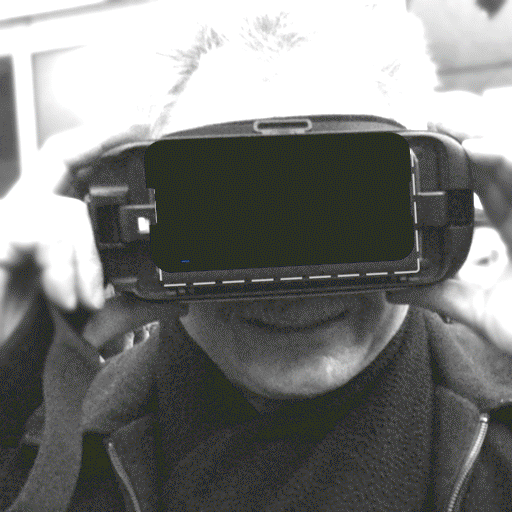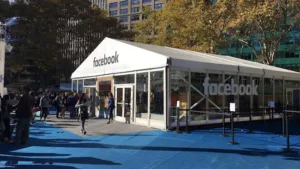December 27 was the last day the Facebook VR roadshow was open to the public in New York City. This was the perfect time to spend some time in the city and enjoy NYC together with a million tourists. While I am not sure about the real tourist number, it sure felt like that. This was the first time in my life where I had to wait on line to leave a store because the sidewalks were so overcrowded!
The Facebook VR roadshow was part of a Christmas village set up in Bryant Park next to the NY library and an ice skating rink. While the ice skating rink remains open until March of 2017, the Facebook roadshow is now moving on to other cities. The event was free for the visitors who just needed a little bit of patience as they had to wait to get their turn with the VR headset and a few minutes of short VR experiences. I reached out to Facebook about their expectations and results with the roadshow, but they wouldn’t share any details on the results in terms of turnout or survey results.
From a quick estimate I would say that they would have had a maximum of about 100 people per hour going through the roadshow, however not all hours were completely booked so I guess that they had about 500 people per day on average for the last five weeks. That would make somewhere in the 15,000 to 20,000 visitor range. That’s not bad for a start to introduce people to this new technology.

Inside the roadshow there were about twenty stations where Facebook employees put a Samsung VR and a stereo headset on the visitors and allowed them to view a short collage of various VR experiences from the circus to the basketball court, to a wild elephant grazing in front of you and a visit of a dinosaur to outer space. All of them showed what VR good be and what a person could expect from such an experience. There was no Oculus Rift available to compare against the Samsung VR. On the positive side the installation was very simple as all content was stored on the Samsung phones and the only cable to content with was the audio cable going from the headset to the headphones.
Three Factors Matter – Content
As I have said before, there are three basic characteristics that influence the adoption of VR at this moment: price, content and the quality of the experience. Facebook didn’t mention any price to me, but the Samsung VR is a low cost solution if you are a Samsung phone user already. There are similar solutions available for other phone types as well, so for the Facebook VR roadshow it comes down to content and quality to convince people of VR as a platform.
From a content perspective the demonstration used basically a 360º video without any interaction. So, no games here. All content was very calm (no sudden movements) without any shocking moments unless you are easily frightened by an elephant grazing 30′ (10m) away and slowly moving towards you or a dinosaur looking at you from five feet distance (1.5m). As a consequence there were no people stumbling around or falling down as their brains anticipated a sudden movement that didn’t happen in real live. We all have seen the YouTube movies of people doing the funniest things while experiencing VR. In one sequence, you were standing on a basketball court while LeBron James drives past you for a layup (a basketball shot). This was somewhat odd as the experience was quite intense as he came closer, but suddenly fell flat as he went past you. I mean this very literally, as James appeared more like a paper cutout the closer he got.
I think the choice of content was a very good decision as most people in the room were putting on a VR headset for the first time. No ugly surprises, then, just pure amazement from the users.
Three Factors – Quality
The quality issue was for me very apparent, as it is exactly the solution I have dismissed as being too short on image quality. The images are very pixelated and the pixels actually show some color break up, especially towards the edges of the field of view. I know that the Oculus Rift and the HTC Vive are better in this regard, but they were not part of the roadshow and come, of course, with a much higher price tag.
To give an example, in one sequence you are on a little boat slowly moving past a little hut with people outside in a distance of maybe 20 feet (6m). It was disturbing to not be able to see any detail in their faces, making the experience somewhat less realistic than it could and should be. Again the immersive nature of this technology makes it difficult for our brains to merge something very realistic with something that our brain expects to see but just doesn’t. These conflicts in our mental processing is something that does not fit our life experience and may cause adverse effects including headaches, nausea , etc.
And Overall?
On the one side, I was impressed by the very conservative way of introducing people to this new medium, but at the same time, I still believe that a phone-based VR solution is for the moment just a teaser for the real VR experience I hope for. As for professional applications, the phone-based solutions are definitely not sufficient to provide the high quality imagery expected in any kind of medical or design-based application.
A couple of my family members saw VR for the first time at the Facebook VR roadshow and had a very similar reaction, “neat but not a must have”. Both are quite avid gamers and could not see the quality being good enough to replace a high end gaming monitor. The reaction may have been different if Facebook had used the Oculus Rift, but it is what it is. In a certain way, for the potential high end user this roadshow is a missed opportunity, while it is a great introduction of the VR concept to the general public. -NH

